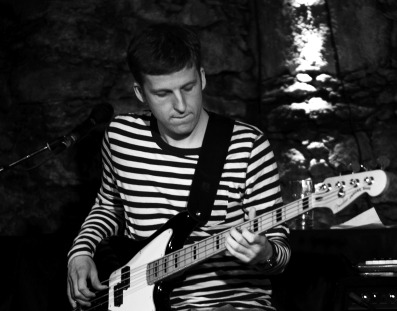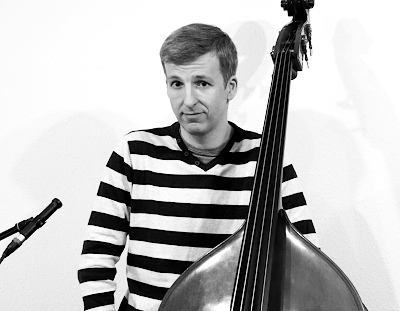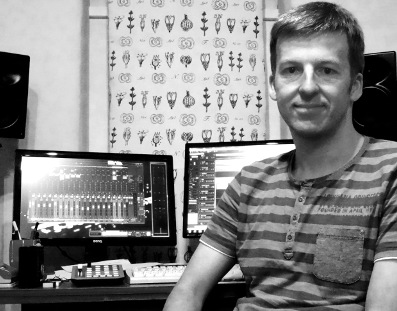Willkommen ...!
Ich schätze sowohl die Schlichtheit eines Songs (gutes Songwriting, gute Texte) als auch die Komplexität von Kompositionen des modernen Jazz.
Neben meiner Arbeit als (Multi-)Instrumentalist liegen mit das Unterrichten sowie die kreative Arbeit im Tonstudio (Arrangieren, Aufnehmen, Mischen und Mastering von Musik) am Herzen.
Welcome ...!
I'm afraid this website is mostly in German but feel free to contact me. However, you can find some information in English if you browse through this website. I added English comments where I found it useful.
Please have a look at my video section!
Rhythm Basics – Dividing the Beat
This lesson shows how to master different subdivisions of the beat, i.e. how to play 1 to 6 notes per beat. Usually called “rhythm pyramid”, this lesson is called “The Rhythm Elevator” here. It includes two exercises: an easier one, and a more advanced one with quintuplets and sextuplets.
topics: rhythm, subdivisions
Level: basic
Instruments: for all instruments
Duration: 7 min
For a list of all my video lessons go here.
You could also use the tag cloud (in the footer area of this website) in order to look for video lessons.
All German-speaking viewers may have a look at my translation page.
Working with opto-style compression (2): mixing a song
As I promised (see my first post on the topic), I’m going to reveal some secrets about my last mix project. It’s kind of a DIY music video, made for my youtube channel. It’s an acoustic ballad, played by Julia Motz and me on two guitars. If you like our music, check out www.motzundteissen.net.
Now here’s how the recording was made: We recorded it on a 4-track basis: 2 mono guitars, 2 mono vocals. That’s it. No compression oder EQing during tracking.
While mixing the audio track for the video, I processed EVERY track as follows:
- phase alignment between the 4 tracks – essential
- (subtractive) dynamic EQ – extremely useful, I use it much more often than a compressor plugin
- fader/gain automation – it’s a lot of work but worth it (again: on all tracks!), no compressor needed!
- if necessary, some light FET-style compression, just to tame the highest peaks
Then I went out-of-the-box, sending EACH track through a IGS ONE LA500 optical compressor, then going back into the DAW again. I processed all 4 tracks with the ONE LA500 applying approx. 3-4 dB gain reduction. (Don’t forget that I did all the necessary corrections before sending the tracks to the opto comp, so I’m using the compressor for subtle compression and overall tone coloration. The tracks should not sound louder in the first place, they should sound BETTER.)
 And though the source material was not “optimal” like a high-end studio recording (due to mic bleeding, the “live” performance and environment), the opto compressor did great on all tracks. The vocals sit great in the mix, and the sustain of some guitar notes and chords was enhanced very nicely. No wonder that for vocal tracks, optical compressors are the first choice of many engineers.
And though the source material was not “optimal” like a high-end studio recording (due to mic bleeding, the “live” performance and environment), the opto compressor did great on all tracks. The vocals sit great in the mix, and the sustain of some guitar notes and chords was enhanced very nicely. No wonder that for vocal tracks, optical compressors are the first choice of many engineers.
The rest was simple. After processing all tracks with a ONE LA500, I finished the mix ITB (in the box), adding a pinch of reverb, buss compression, and the usual sh**. For me, this mix sounds richer than my last one, where I was mixing without outboard gear. The IGS ONE LA500 will not only be my go-to comp on bass (as I’ve shown in my last post) but also on vocals, and probably on acoustic guitars too …
Oh, and here’s what it sounds like (don’t forget, the audio quality deteriorates due to youtube’s video encoding, but still …). I hope you like the result! Cheers, Tim
M.U.T. – Sophie (Original song)
Das neue, mittlerweile siebente Video von Motz & Teissen (M.U.T.) stellt wieder einen eigenen Song ins Zentrum: “Sophie”, geschrieben von Julia Motz.



